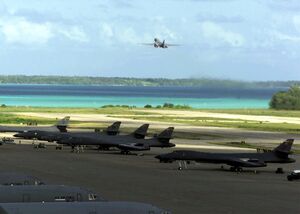Keanuan Defence Forces (KDF) (Pacifica)
| Keanu and Hurley Defence Forces | |
|---|---|
| Keanu a Hurley Pū’ali Koa | |
 Coat of arms of the Keanu and Hurley Defence Force | |
| Motto | mai hoopa mai ia'u (Kenauan: "Don’t touch me”) |
| Founded | Antiquity |
| Current form | 1602 |
| Headquarters | Fort Mona Loa, Keanu |
| Leadership | |
| Commander-in-Chief | King Keanu |
| Minister of Defence | Chief Komodo |
| General | Leilani Hurley |
| Manpower | |
| Military age | 18 |
| Conscription | 6 month service obligation |
| Active personnel | 1,500 Regulars, (1,800 Conscription) |
| Reserve personnel | 42,000 |
| Expenditures | |
| Budget | $103.52 million (2022) |
| Percent of GDP | 2.0% of GDP (2022) |
| Industry | |
| Domestic suppliers | Ohayo Sea Planes Irwin Boat Builders |
| Foreign suppliers | Volksmobil (Gianatla) Rampart (USI) Sallocopter (Sallodesia) Taiga (USI) Razor (USI) Koyuki (Frost Empire) |
The Keanu and Hurley Defence Forces (Keanuan: Keanu a Hurley, Pū’ali Koa), are the unified armed forces of the Oceanic Kingdom of Keanu and Hurley. The armed forces are organised under a single command structure with 3 sub-divisions: Defence Force, Marine Division and the Air Division.
National service is required in Keanu and Hurley for both men and women, for military service the period is 6 months, and for civilian service the period is 12 months, making military service the most popular option. The active force is about 1200 regular military and 1800 conscripts. The reserve force is about 42,000, accounting for half the adult population, with arms kept in depots on each island for all reserves.
Keanu and Hurley has remained at peace since the collapse of piracy in 1775. Day to day the KDF is responsible for maintaining the territorial integrity of Keanu and Hurley, and does not participate in overseas conflicts or peace keeping missions. The largest Keanuan engagement in modern history is the 2023 Hostage Crisis where 45 Keanuan service people were killed in an offensive operation on the island of Jaques.
Most of the equipment of the Kenauan Defence Forces is manufactured by 5 friendly powers that Keanu and Hurley balances to avoid over-dependence on a single foreign power. Those foreign powers are The USI, Sedunn, The Frost Empire, Sallodesia and Gianatla
Mission and doctrine
The official mission of the KDF is to maintain the territorial integrity of Keanu and Hurley and protect its citizens from threats domestic, foreign or natural. The KDF regularly participates in disaster relief efforts, border and drugs enforcement and counter-poaching enforcement. Keanu and Hurley does not engage overseas in any capacity unless there is a direct threat to Keanu and Hurley.
Keanu and Hurley pursues a defence doctrine it calls the Snapper Turtle. The Snapper Turtle doctrine has been the backbone of Kenauan defence since time immemorial, the principle is to be protected by a hard defensive shell absorbing the brunt of the attack, and then to strike hard when an enemy is drawn in.
International Deployments in Keanu and Hurley

Keanu and Hurley regularly hosts international forces for training exercises, particularly those of Sedunn, The Frost Empire and The USI. The Frost Empire also maintains a Frost Air Force presence at the Hurley airstrip on a 30 year agreement after they provided funding to rebuild the damaged runway.
The Frost Empire, Sedunn and The USI provide advanced defence capabilities and air patrols on behalf of Keanu and Hurley.
During the Hostage Crisis, all three nations provided military support to Keanu and Hurley.